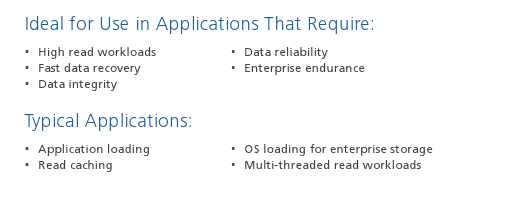Micron's RealSSD P400e: Affordable SSD Storage For The Enterprise?
RealSSD P400e: Aiming For Entry-Level Enterprise
Enterprise-oriented SSDs armed with premium NAND often sell for $5/GB and up. That's an expense many IT professionals gladly pay, if only for the reliability they afford, which translates to fewer failed drives, less downtime, and, ideally, a more cost-effective experience.
Increasingly, though, we're seeing this concept of "entry-level" enterprise solid-state storage that doesn't cost as much, doesn't need to offer the same unflagging endurance, and can be easily swapped out when it fails. Read caching, for example, is an excellent application for less expensive SSDs. Micron adds that its P400e is also well-suited to application loading and as an operating system boot device.
While the company's SLC NAND-based P300 tackles the high-end space, its P400e becomes the company's MLC NAND-based entry-level enterprise offering. We know they're not intended to do the same thing, nor did we expect the newer model to outmaneuver its predecessor. The P400e is best suited to workloads that push sequential reads, a fact that's made clear by its 450 MB/s performance numbers.
Random I/O is far less attractive. Once in a steady state, the P400e sheds so much performance that it becomes worryingly slow.
For what it does well, the P400e is a respectable choice. You simply need to know your workload and pick storage that's appropriate to it. Our main problem with the P400e is that its price tag doesn't necessarily reflect entry-level enterprise positioning. At launch, the company suggested that the 200 GB model we're reviewing would sell for around $330 (using disti pricing). Instead, it's going for more than $550 on two different online vendors. That's a big difference, and we have to imagine many businesses will choose more well-rounded "desktop" SSDs priced closer to $1/GB instead.
Intel's SSD 520, for example, can best or at the very least match the performance of Micron's P400e in decidedly enterprise workloads—even with a lower price and longer five-year warranty. We demonstrated the SSD 320 falling behind Micron's newer drive in sequential reads, but it excels in random I/O. Perhaps the more attractive option would be Intel's newer SSD 330, though, which centers on a SandForce controller and adds SATA 6Gb/s to the mix.
The P400e's niche is further constrained by its MLC NAND, which compels the same warning we'd give an IT pro about any other MLC-based drive. Basically, if you subject it to heavy writes (sequential writes, in the case of our endurance testing), it's going to wear out. And faster than an Intel SSD 320, if our numbers are accurate. This is an issue for the P400e because, although it sports a uniquely-tuned firmware and tons of over-provisioning, those don't necessarily appear to be competitive advantages.
Get Tom's Hardware's best news and in-depth reviews, straight to your inbox.
With all of that said, Micron knows what it takes to succeed in the enterprise space. Its P300 dominates as the most cost-effective SLC-based drive, which is why SoftLayer, a company that reportedly hosts more than 81 000 servers, purchased a few thousand P300s when Intel phased out its X25-E. But in order to enjoy that same success in the fledgling entry-level enterprise space, it needs to find a way to either offset the lower endurance of its MLC NAND or come up with a way to bring the P400e's price tag down closer to its original distribution numbers.
Price-conscious IT professionals are already deploying Intel's desktop SSDs in applications that can tolerate them. ZT Systems, for example, has one client that uses more than 150 000 X25-Ms. Likewise, Micron is eager to build its customer base of businesses leaning on a tiered storage structure, and it's positioning the P400e to establish some cachet with the entry-level buyer. What Micron's RealSSD P400e needs more than anything is an entry-level price able to do battle with competing solid-state solutions.
Current page: RealSSD P400e: Aiming For Entry-Level Enterprise
Prev Page Enterprise Workload Performance-
ethanolson I wonder if the poor performance is part of some mechanism that ensure higher reliability. Maybe lower read and write voltage increase endurance but take longer to populate the cell with the appropriate charge level.Reply
Just sayin'. -
mayankleoboy1 ReplyRelease Date: 04/11/2012
Firmware for the m4 SSD is being updated from version 0309 to 000F. The m4 is updatable to this new firmware starting from versions 0001, 0002, 0009, or 0309 in a single step. If updating from an early version directly to 000F, all interim improvements will also be include.
Changes between version 0309 and 000F include the following changes:
Improved compatibility with certain SAS expanders and peripheral RAID cards.
Improved throughput stability under extremely heavy workloads.
Improved data protection in the event of unexpected, asynchronous power loss.
This firmware update is recommended for all drives currently in the field if the end user is experiencing any of these symptoms.
m4 firmware updated to a newer version. -
jaquith Seems like the perfect SSD for a third-rate data center and not mine.Reply
If SoftLayer (f/k/a ThePlanet) wants to lower their standards then good for them, and perhaps they need yet another law suit or reevaluate their published up-time with some more asterix *. -
lutel The only thing that is important for me is full disk encryption in desktop environment. Unfortunately Intel completly forgot and since Q66 chipset there is no mainboard supporting FDE with SSDs. Q77 probably could support it, but there is no BIOS that has "hard disk / ATA password" option. Intel, wake up!!!Reply -
cknobman Not impressed at all. I dont really see one redeeming feature this drive has that would get it chosen over many other SSD's on the market.Reply -
Is it just me or do I notice that we really need to SAVE SLC from extinction? I mean, naturally high performance (compression or none), better temperature control, and higher longevity are the greatest features of SLC - good for the environment, pocketbooks, and peace of mind long term. Anyone?Reply

